Waking at the Tara Palace Hotel holds many small pleasures. There is this most comfortable of beds, so wide I can barely reach across to Michael, even with my long arms. There are the many dreams I dream here, to be remembered. It is a long time since I had the space for that pondering, and it is deeply healing. Then I think of the world outside, and pull across the curtains.
If I step out to the narrow balcony, I can see to one side the beauty of the Red Fort (Lal Qila) and think “We are really in Delhi again!” The morning sky is always full of circling birds – kites and pigeons, wings stretched on the currents, some with beaks full of branches for nest building. They fly over the red Shiva Temple, the white Jain Temple, over the roofs of the endless hidden alleys that encircle Chandni Chowk. They fly over the woman saying her morning prayer on a roof below, and over the monkeys, which are stalking the balconies and sliding across the power lines, making me shut the door in a hurry.
Below, most days, a small boy in bare feet and shorts flies a kite from a junk-laden back yard; despite being deluged by higher buildings, he manages to get the red paper toy aloft, but nearly always loses it on a snag of a neighbour’s roof. I point to where it is, and sometimes he can climb, dangerously, to retrieve it. Almost each day, though, he loses a kite, and must make a new one. Another neighbour, high above, teases the boy by catching the kite, then ducks beneath the balcony – but by sign language I let the boy know of this perfidy, and we all laugh.
It must have been such a different world here once, when the havelis and their rooftops were full of kite-flying, pigeon-racing neighbours and relatives, all knowing each other’s place in society, each other’s business, joys and sadnesses, in this Islamic corner of the city. It is described poignantly in Ahmed Ali’s classic novel of that pre-Partition world, Twilight in Delhi; Ali mourns that “gone are the poets too, and gone its culture”.
But all cultures change, for better and 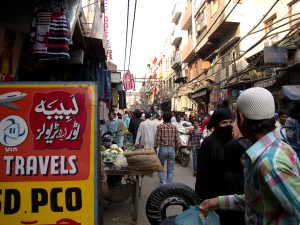 worse, and besides, Old Delhi’s galis, the labyrinthine laneways that branch off Chandni Chowk, still wear the patina of traditional ways. The foods frying on the street sides are surely the same foods, the tradesmen banging metal or sewing leather on their little patch of ground use inherited skills. The snatches of music or song on people’s lips (for they sing, often), the little boy lingering at the sweetshop – these must be essentially the same as a century ago. Dogs curl up amongst the hurrying feet on a crowded pavement and people, unminding, step around them; a man carries a goat which has refused to be led. Unbelievably, shockingly, a tiny, twisted human form
worse, and besides, Old Delhi’s galis, the labyrinthine laneways that branch off Chandni Chowk, still wear the patina of traditional ways. The foods frying on the street sides are surely the same foods, the tradesmen banging metal or sewing leather on their little patch of ground use inherited skills. The snatches of music or song on people’s lips (for they sing, often), the little boy lingering at the sweetshop – these must be essentially the same as a century ago. Dogs curl up amongst the hurrying feet on a crowded pavement and people, unminding, step around them; a man carries a goat which has refused to be led. Unbelievably, shockingly, a tiny, twisted human form 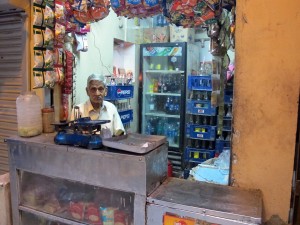 wrapped in grimy rags slithers by on the ground. Imagine, to live that way… But there are groups of women in black niqab disappearing down even narrower byways, hurrying home to the school children who, bunched in a rickshaw bus, chatter and push; shopkeepers, lazing but alert in their doorways, are casual in white caps and loose white salwar qamiz, seeing everything with half closed eyes.
wrapped in grimy rags slithers by on the ground. Imagine, to live that way… But there are groups of women in black niqab disappearing down even narrower byways, hurrying home to the school children who, bunched in a rickshaw bus, chatter and push; shopkeepers, lazing but alert in their doorways, are casual in white caps and loose white salwar qamiz, seeing everything with half closed eyes.
Ahmed Ali writes of these alleyways, that “insidious as a game of chess intersect the streets and the city like the deep gutters which line them on either side, and grow narrower as you plunge into them, giving a feeling of suffocation and death, until they terminate at some house front or meet another net of by-lanes as insidious as before”. Not feeling quite “suffocation and death”, still, in the heat we fear the exhaustion of being lost, and are glad to find the light of a slightly wider “main” road.
The spice market, Khari Baoli, is at one end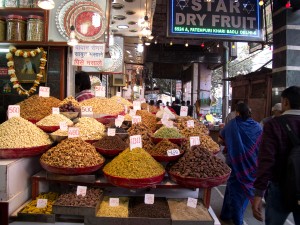 of Chandni Chowk and is recommended to tourists for its colour and activity (mounds of spices, great baskets of raisins, nuts, rices, pulses and unidentifiable goods that look like bits of rock, or bark). One evening we had walked to Kinari Bazaar, just around the corner from Tara Palace, via Dariba Kalan, the jewellers lane, where we tried the perfume oils at a famous perfumery (subtle, soft, elusive) and looked in at the small shopfronts displaying expensive silver and gold earrings, bracelets, necklaces set with glittering gemstones, or shining with carved designs. Off to the left, Kinari Bazaar sells the paraphernalia for weddings, which are great affairs, requiring much sparkle and colour.
of Chandni Chowk and is recommended to tourists for its colour and activity (mounds of spices, great baskets of raisins, nuts, rices, pulses and unidentifiable goods that look like bits of rock, or bark). One evening we had walked to Kinari Bazaar, just around the corner from Tara Palace, via Dariba Kalan, the jewellers lane, where we tried the perfume oils at a famous perfumery (subtle, soft, elusive) and looked in at the small shopfronts displaying expensive silver and gold earrings, bracelets, necklaces set with glittering gemstones, or shining with carved designs. Off to the left, Kinari Bazaar sells the paraphernalia for weddings, which are great affairs, requiring much sparkle and colour.  Gold and red metallic bunting and tinsel, and gaudy decorations of all kinds are lit up like fairyland, dazzling and vivid, and many, many people are there for their pre-wedding shopping – it is wedding season. So many people, in fact, and the odd cycle rickshaw full of passengers, that a serious traffic jam occurs in this six foot wide thoroughfare. Struggling to find a place to put my foot down, I peer at the ground for any small movement that will give me advantage, while remembering to avoid being run over or prodded by the cycle rickshaw at my hip. It is an inescapable thought that when humans can no longer take a step for the crush of each other, there are just too many of them. But India carries on its burgeoning population growth, unheeding, it seems.
Gold and red metallic bunting and tinsel, and gaudy decorations of all kinds are lit up like fairyland, dazzling and vivid, and many, many people are there for their pre-wedding shopping – it is wedding season. So many people, in fact, and the odd cycle rickshaw full of passengers, that a serious traffic jam occurs in this six foot wide thoroughfare. Struggling to find a place to put my foot down, I peer at the ground for any small movement that will give me advantage, while remembering to avoid being run over or prodded by the cycle rickshaw at my hip. It is an inescapable thought that when humans can no longer take a step for the crush of each other, there are just too many of them. But India carries on its burgeoning population growth, unheeding, it seems.
In the quieter alleys, small, productive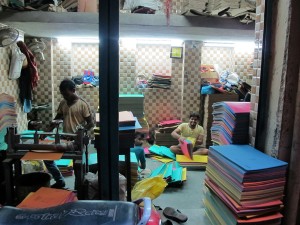 factories exist in single rooms. Here is one making paper, sheets of coloured cardboard; next door, a printing press churns out pamphlets and newspapers; across the way some men work in a low room semi underground, at some unknown task. Two people discuss business in a dusty shop selling odd antiques, which has a suspicious air. There is a sense of admirable autonomy in these small private enterprises. A kindly, portly man presses upon us two bronze Ganesha statues, to welcome us to India. (Later, I would leave mine behind in Landour, and succumbing to superstition, fear that I have lost my luck). In all, the streets of Old Delhi hold many remnants of past ways, and although some residents claim underdevelopment is deliberate, so that they can be kept as an “underprivileged ethnic vote bank”, there are perhaps equally many who treasure the familiarity and value of traditional ways, even as they become more educated and financially advanced.
factories exist in single rooms. Here is one making paper, sheets of coloured cardboard; next door, a printing press churns out pamphlets and newspapers; across the way some men work in a low room semi underground, at some unknown task. Two people discuss business in a dusty shop selling odd antiques, which has a suspicious air. There is a sense of admirable autonomy in these small private enterprises. A kindly, portly man presses upon us two bronze Ganesha statues, to welcome us to India. (Later, I would leave mine behind in Landour, and succumbing to superstition, fear that I have lost my luck). In all, the streets of Old Delhi hold many remnants of past ways, and although some residents claim underdevelopment is deliberate, so that they can be kept as an “underprivileged ethnic vote bank”, there are perhaps equally many who treasure the familiarity and value of traditional ways, even as they become more educated and financially advanced.
On Sundays, the Darya Ganj Book Market is held, just a few blocks away. Second hand and new books, magazines, intriguing old papers, are spread for several kilometres along the footpaths, and I have read that the film-poster-wallah is always there, under the Sablok Sex Clinic sign. We perch on a cycle rickshaw whose semi emaciated driver wobbles off across the horrible crossing at Jama Masjid with his two heavy passengers.
There is no joy for me in a cycle rickshaw ride, which in good circumstances can be peaceful and smooth because of its quietness. I feel great tension and guilt the whole time because the poor man must pull my weight. Yet he longs for customers, his livelihood, and we pay far more than necessary, to the rickshawalla’s delight, bargaining for a fair price but tipping well at the end of the journey. The spontaneous pleasure in his smile then is a real gift to our shared humanity. These men work hard for their money –a pittance – ruining their health while doing so, struggling in all weathers and through the most dreadful pollution.
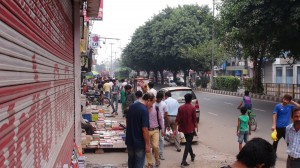 This time, safely delivered to the market, we walk in the hot sun, scanning the thousands of books until spotting the Sablok Clinic sign. But no-one has even heard of poster wallah, and he certainly isn’t there. Disappointed, though with a new found copy of Martin Buckley’s book An Indian Odyssey tucked in my bag, we decide to go a little further and visit Paharganj. A storm seems to be approaching; the humidity is terrible.
This time, safely delivered to the market, we walk in the hot sun, scanning the thousands of books until spotting the Sablok Clinic sign. But no-one has even heard of poster wallah, and he certainly isn’t there. Disappointed, though with a new found copy of Martin Buckley’s book An Indian Odyssey tucked in my bag, we decide to go a little further and visit Paharganj. A storm seems to be approaching; the humidity is terrible.
Again, cycle rickshaw is the only option. 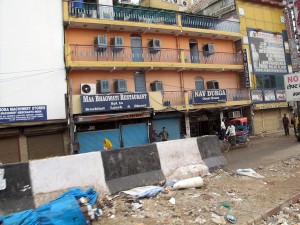 Although Paharganj is near as the crow flies, to drive there requires quite a circling about, to avoid the main railway line and the river. Our valiant man sets off through unedifying backstreets of truck pits and construction, broken roads and slum-like housing blocks, and as we begin to climb the curve of the bridge, the storm breaks. He jumps off to push the bike up the slope; Michael leaps off too and pushes from behind, while I sit queen-like (but conscience stricken) and we all become soaked with rain. It keeps
Although Paharganj is near as the crow flies, to drive there requires quite a circling about, to avoid the main railway line and the river. Our valiant man sets off through unedifying backstreets of truck pits and construction, broken roads and slum-like housing blocks, and as we begin to climb the curve of the bridge, the storm breaks. He jumps off to push the bike up the slope; Michael leaps off too and pushes from behind, while I sit queen-like (but conscience stricken) and we all become soaked with rain. It keeps 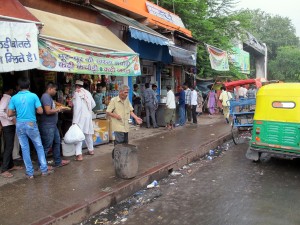 bucketing down, and half way along Main Bazaar in Paharganj we say “enough’ and alight in puddles of water, on this familiar territory.
bucketing down, and half way along Main Bazaar in Paharganj we say “enough’ and alight in puddles of water, on this familiar territory.
Paharganj is often denigrated as “backpackers ghetto”, especially by Indians themselves, who expect respectable westerners should stay in 5 star hotels in New Delhi or in expensive homestays in central South Delhi. But Paharganj is an area very convenient for walking into New Delhi, and even closer to the main railway station; besides, beyond the one tourist strip, it is surrounded by the fascination of daily life going on, with its trivialities and celebrations. Women squabble at a well, men wash at a water pump. Children play, running, along alleyways. Temple bells ring. A wedding procession blares its way past –once, with an elephant in the lead. Deals are done in small businesses and warehouses, and just around the corner is a leafy old Christian cemetery. This day, a religious procession of many floats pulled by white brahmin bulls blocks the road near the metro station, itself another, newer convenience. In the evenings, the vegetable market is a delight. Here I woke 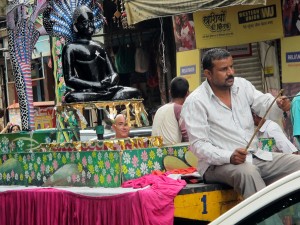 up in India for the first time, many years ago; here too, from a hotel window, I once saw the riotous Holi festival exploding in colour below. I have loved Paharganj, and wanted to say farewell, as the next day we will leave, taking the Dehra Dun Shatabdi Express north to Hardwar, at the foot of the Himalayas. And this time, I sense I will never again return to Delhi.
up in India for the first time, many years ago; here too, from a hotel window, I once saw the riotous Holi festival exploding in colour below. I have loved Paharganj, and wanted to say farewell, as the next day we will leave, taking the Dehra Dun Shatabdi Express north to Hardwar, at the foot of the Himalayas. And this time, I sense I will never again return to Delhi.
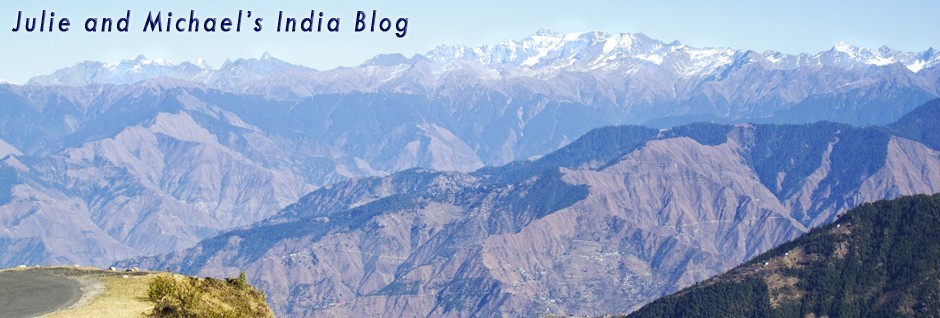
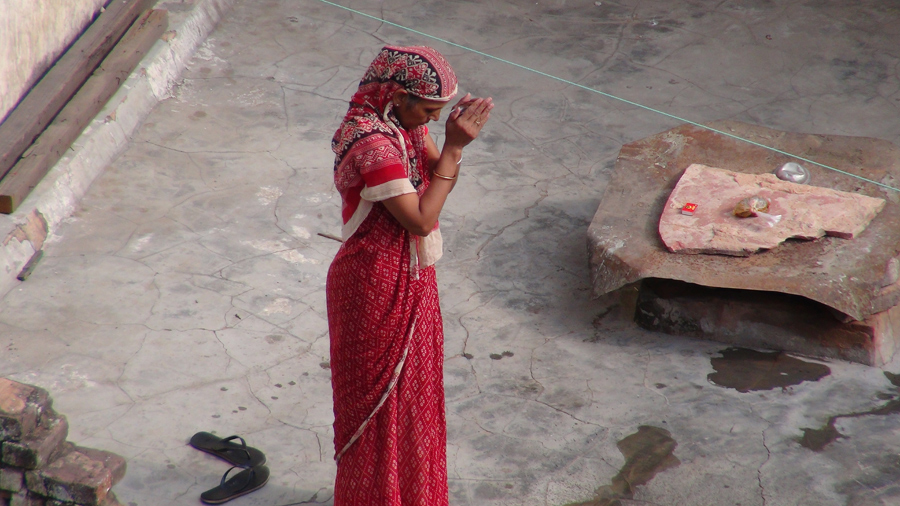

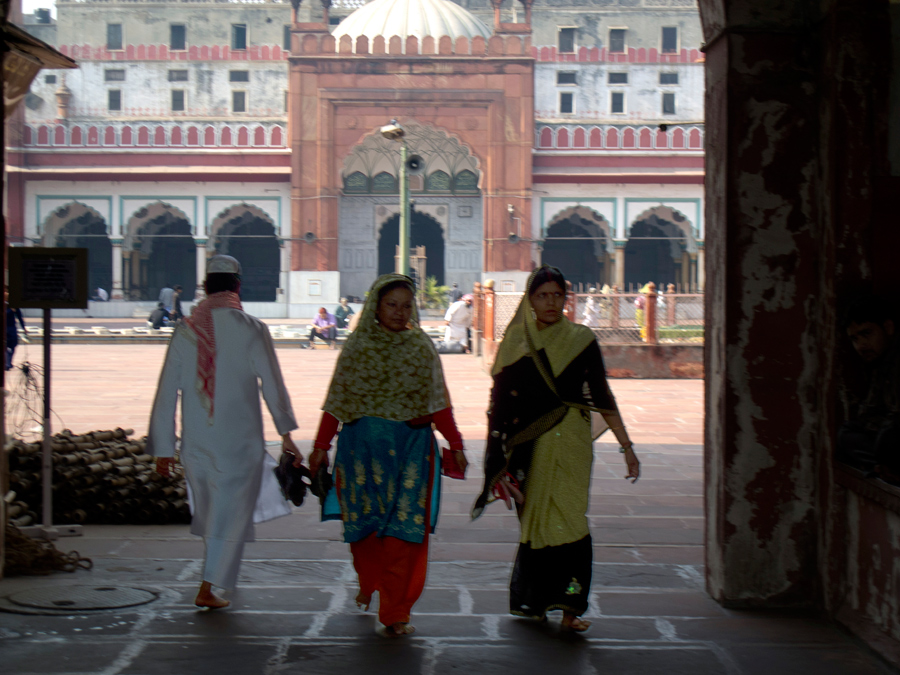
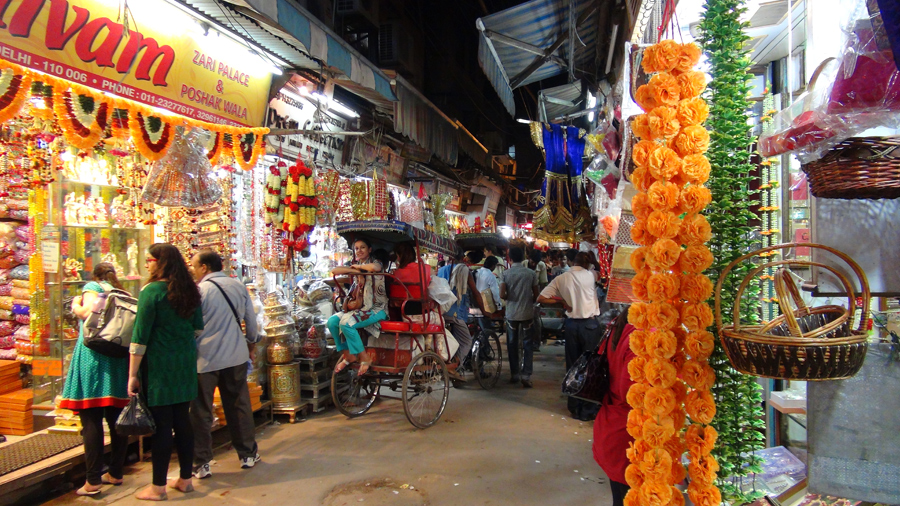
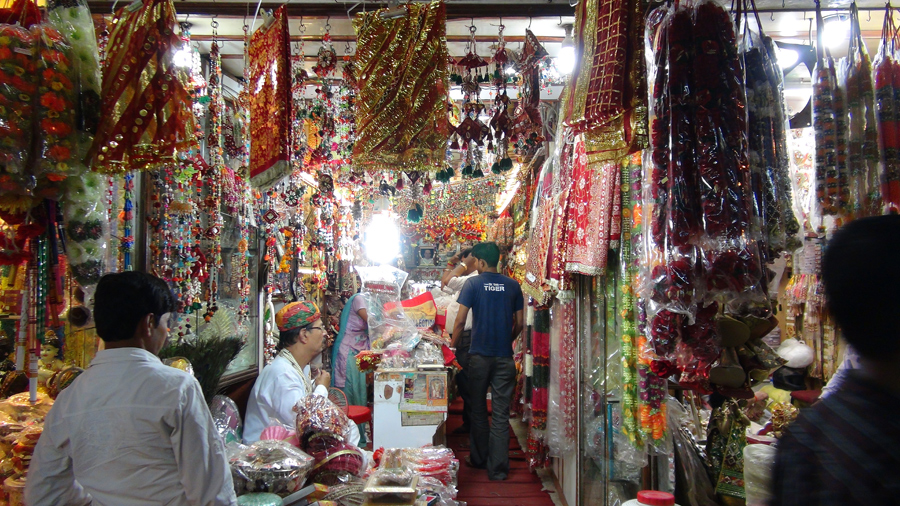
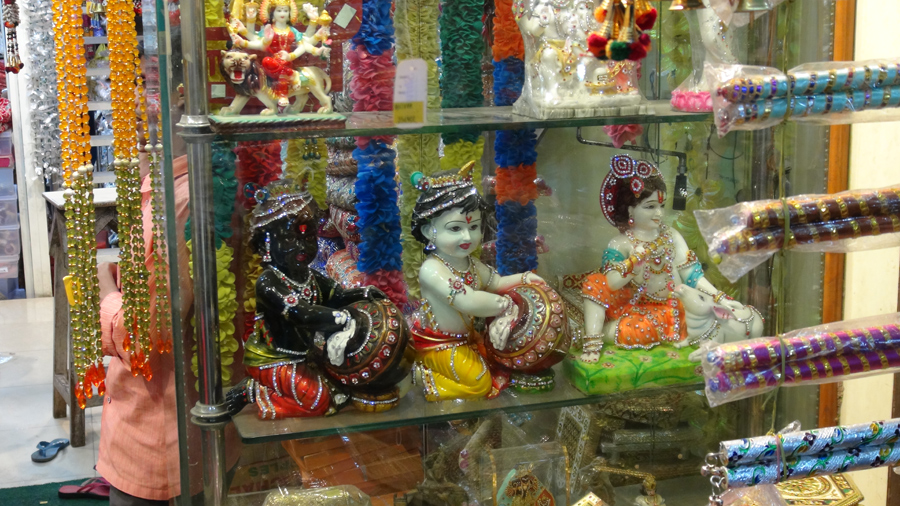

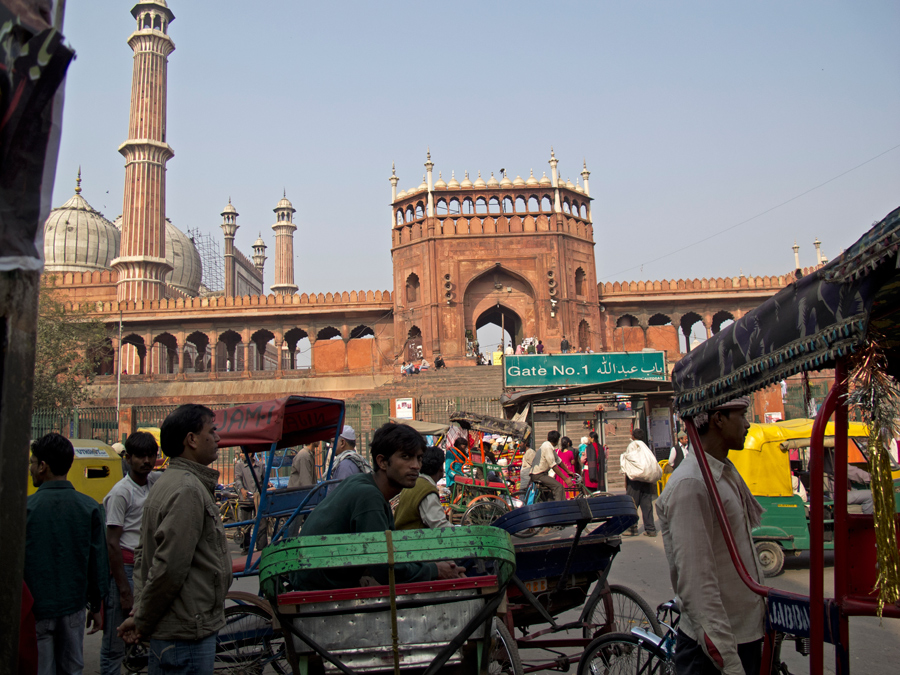


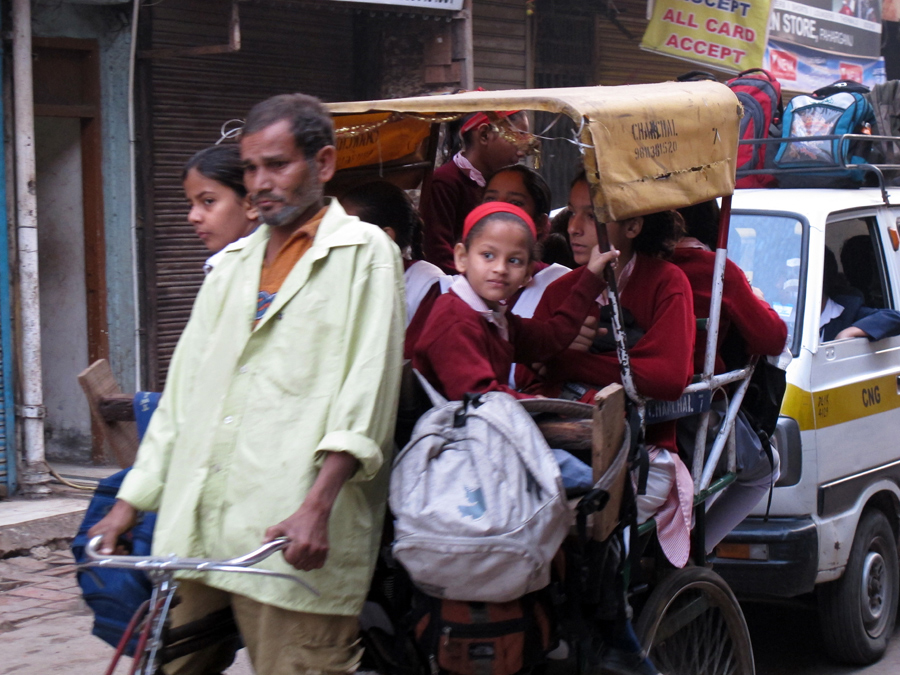

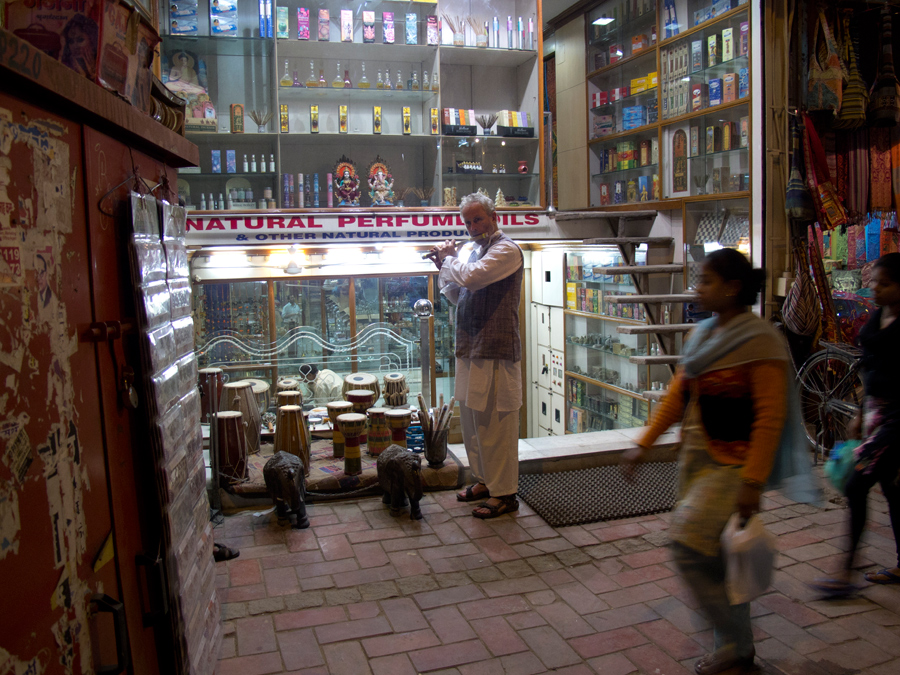
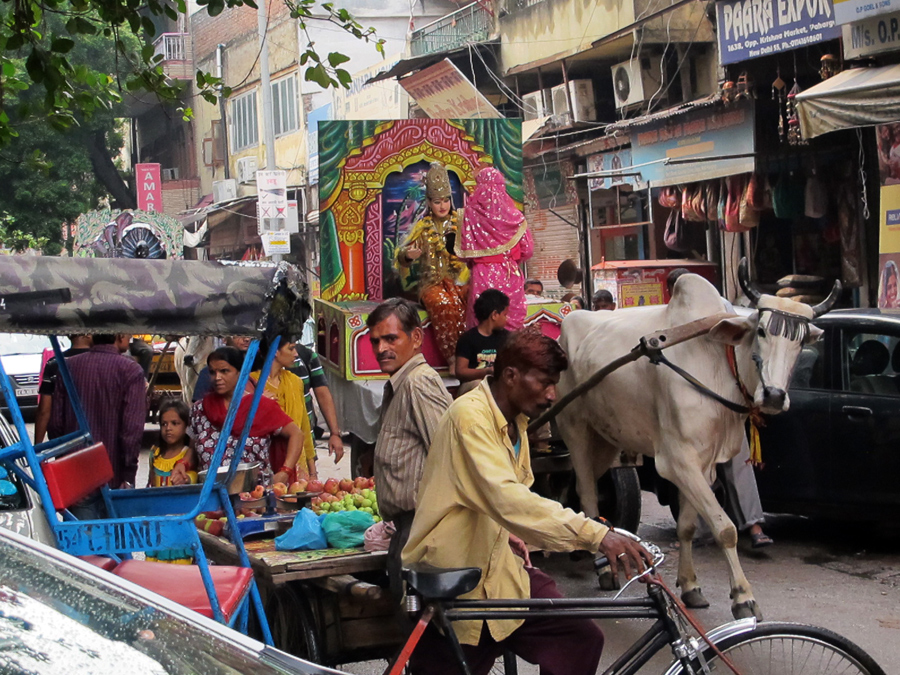
I feel so sad that you are saying goodbye to Delhi for good. Perhaps you will change your mind when you start writing at home. Your posting, Julie, starts off like a good novel — one that I wouldn’t be able to put down after the first paragraph. The photographs are so familiar, even though I’ve never been to India. The bazaars, the street life, the thousands of small businesses operating on the foot path and in tiny shops, the kids everywhere, people living their lives in the open on the streets, their homes too small, too hot and too stuffy to endure. Your wide hotel bed was probably the size of the average home or shop. And having to be aware of every step you take — the ubiquitous broken pavement, the discarded hot charcoals from the myriad cooking stoves, the narrow streets meant only for bullock carts but now jammed with cars and motorcycles. Religious icons everywhere. I just love the last photo of the cow/bullock (?) looking straight into your camera as it pulls the goddess through the street. It’s when you step out of the airport in Armidale, Australia, that the culture shock starts. Silence. Emptiness. Did I go deaf on the plane? Did someone drop the neutron bomb?
Perhaps the population problem can be directly linked to all those weddings :), Carl commented. He says your writing is very poetic. I agree.
You left two bronze Ganesha figures behind! You should have consulted me, as I would have paid the postage and transferred the good luck to myself.
Oh Joan, you’re right about the bed being the size of a family home, for some! Such disparity creates constant concern, as you know yourself from SE Asia. It requires in the end a philosophic stance of some kind and an eyes (and mind)-half-shut existence. I’ll have to try to define that stance, won’t I…a challenge.
I also love that bullock (Brahmin bull) looking at the camera! They are beautiful creatures, as are the water buffalo. Yesterday at the beach here we saw a water buffalo swimming in the sea, underwater for much of the time! Incredible! By the way, I think that procession was all the incarnations of Vishnu.
It was only my Ganesh left behind (Michael has his), and I phoned the woman who owned the guest house asking her to keep it (as I liked her very much). Too much to ask her to post it on – such an effort to post things here.
Yes – the very eerie silence of Australia, so noticeable on return… in Armidale at least. Once we get out into the country I enjoy the ‘silence’ of birds, lambs, the breeze in the trees – ah..
Thank you for enjoying these posts. I appreciate it 🙂
Thank you Jule dear for sharing another marvellously written glimpse of India. There is so much to see wherever one looks, so many details, so much noise and chaos, and you have described it perfectly. I can see it so clearly in my minds eye. I especially loved your interaction with the kite flying boy and his “tormentor”. That was one of those lovely spontaneous personal moments that are so enriching and real. I can see from the photos that India has not changed much since we were there 🙂 I have been talking to Inders brother and sister-in-law who are here for the wedding. It is the first time they have been outside India. They commented that what they love about Australia is, guess what, the clean air, clean streets, lack of crowds, and physical beauty, and they want to visit again sometime. I’ll email you soon.